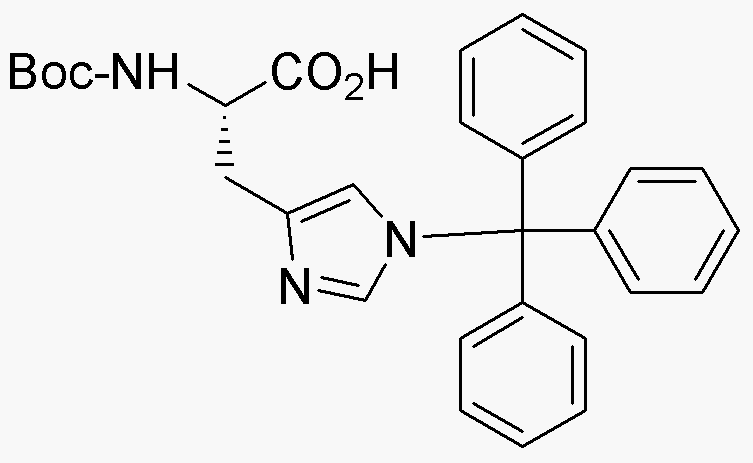Na-Boc-Nim-trityl-L-histidine is widely utilized in research focused on:
- Peptide Synthesis: This compound serves as a protecting group in the synthesis of peptides, allowing for selective reactions without unwanted side reactions. Its stability under various conditions makes it a preferred choice for researchers.
- Drug Development: It plays a crucial role in the development of pharmaceutical compounds, particularly in designing histidine-containing drugs that can target specific biological pathways effectively.
- Bioconjugation: The compound is used in bioconjugation processes, where it helps attach biomolecules to surfaces or other molecules, enhancing the functionality of drugs and diagnostic agents.
- Research in Enzyme Activity: Researchers utilize it to study enzyme mechanisms and interactions, particularly those involving histidine residues, providing insights into enzyme function and regulation.
- Protein Engineering: It aids in the modification of proteins to improve their stability and activity, which is essential in various biotechnological applications, including the development of biosensors and therapeutic proteins.
General Information
Properties
Safety and Regulations
Applications
Na-Boc-Nim-trityl-L-histidine is widely utilized in research focused on:
- Peptide Synthesis: This compound serves as a protecting group in the synthesis of peptides, allowing for selective reactions without unwanted side reactions. Its stability under various conditions makes it a preferred choice for researchers.
- Drug Development: It plays a crucial role in the development of pharmaceutical compounds, particularly in designing histidine-containing drugs that can target specific biological pathways effectively.
- Bioconjugation: The compound is used in bioconjugation processes, where it helps attach biomolecules to surfaces or other molecules, enhancing the functionality of drugs and diagnostic agents.
- Research in Enzyme Activity: Researchers utilize it to study enzyme mechanisms and interactions, particularly those involving histidine residues, providing insights into enzyme function and regulation.
- Protein Engineering: It aids in the modification of proteins to improve their stability and activity, which is essential in various biotechnological applications, including the development of biosensors and therapeutic proteins.
Documents
Safety Data Sheets (SDS)
The SDS provides comprehensive safety information on handling, storage, and disposal of the product.
Product Specification (PS)
The PS provides a comprehensive breakdown of the product’s properties, including chemical composition, physical state, purity, and storage requirements. It also details acceptable quality ranges and the product's intended applications.
Certificates of Analysis (COA)
Search for Certificates of Analysis (COA) by entering the products Lot Number. Lot and Batch Numbers can be found on a product’s label following the words ‘Lot’ or ‘Batch’.
Número de catálogo
Número de lote/lote
Certificates Of Origin (COO)
This COO confirms the country where the product was manufactured, and also details the materials and components used in it and whether it is derived from natural, synthetic, or other specific sources. This certificate may be required for customs, trade, and regulatory compliance.
Número de catálogo
Número de lote/lote
Safety Data Sheets (SDS)
The SDS provides comprehensive safety information on handling, storage, and disposal of the product.
DownloadProduct Specification (PS)
The PS provides a comprehensive breakdown of the product’s properties, including chemical composition, physical state, purity, and storage requirements. It also details acceptable quality ranges and the product's intended applications.
DownloadCertificates of Analysis (COA)
Search for Certificates of Analysis (COA) by entering the products Lot Number. Lot and Batch Numbers can be found on a product’s label following the words ‘Lot’ or ‘Batch’.
Número de catálogo
Número de lote/lote
Certificates Of Origin (COO)
This COO confirms the country where the product was manufactured, and also details the materials and components used in it and whether it is derived from natural, synthetic, or other specific sources. This certificate may be required for customs, trade, and regulatory compliance.


